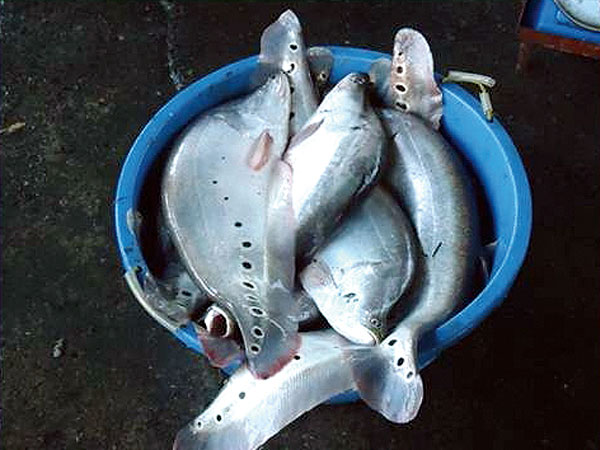
THE HIGHLY carnivorous knife fish wreaks havoc in the aquaculture industry in Laguna Lake. CONTRIBUTED PHOTO
DAGUPAN CITY—If you can’t lick them, eat them. Or feed them to other fish.
The knife fish, an ornamental fish whose population has boomed and is harming the aquaculture industry in Laguna Lake, will be converted into fish meal and fed to sea bass cultured at the Bureau of Fisheries and Aquatic Resources (BFAR) research center here.
Westly Rosario, BFAR research center chief, said that during a recent meeting with Adelaida Palma, chief of the National Inland Fisheries Technology Center in Rizal, they decided that the knife fish collected in Laguna de Bay would be processed into fish meal and fed to sea bass fry and fingerlings.
Palma said the knife fish, called as such because of its shape and its ability to grow up to a meter long, is an invasive species and is a big threat to the biodiversity of Laguna de Bay and aquaculture operations in the lake.
She briefed reporters from Luzon on how the BFAR is containing the knife fish during the environmental media conference conducted on Feb. 9 by Tanggol Kalikasan and the BFAR.
“Knife fish arrived in the country through the importation of aquarium or ornamental fish. Because of floods, it escaped from hatching areas into Laguna de Bay,” she said.
Palma said the knife fish is aggressive and highly carnivorous, and its mouth is equipped with razor-sharp teeth, a bony tongue and equally sharp gill rakers.
Fish pen operators, Palma said, are suffering from losses because the knife fish lays eggs on stakes and poles in the fish pens.
Fry from the knife fish eat bangus and tilapia, and “they also eat shrimps,” said Palma.
The knife fish is so prolific that it can lay 20,000 to 60,000 eggs, Palma said.
The threat from the knife fish to the fishing industry in Laguna de Bay is shown by a recent survey conducted by the BFAR among 2,519 fishermen representing 43.67 percent of affected fishermen.
The survey showed that knife fish comprised 40.35 percent of the total catch while harvest of aquaculture fish is much less: Tilapia, 24.15 percent; carp, 15.92 percent; and milkfish, 0.58 percent.
Palma said the knife fish has to eat 7 kilograms of different types of fish to grow to a kilogram. “The fish it eats costs an average of P150 a kg while the knife fish is so cheap at P18 to P20 a kg. So the fishermen are really at a losing end,” Palma said.
Fishery authorities, she said, are now conducting a massive campaign to collect knife fish. Eleven towns and a city in Laguna agreed to turn over all collected knife fish so these could be processed into feeds and other products.
“The bones could be turned into decors while the flesh could be turned into fish meal and even fish nuggets, siomai or patties,” Palma said.